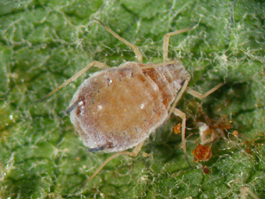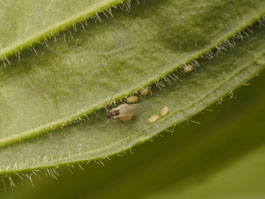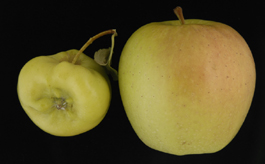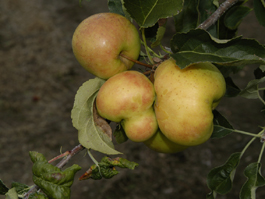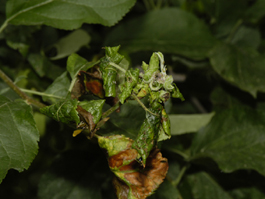by Elizabeth H. Beers and Michael J. Willett, originally published 1993; revised December 2007
Dysaphis plantaginea Passerini (Homoptera: Aphididae)
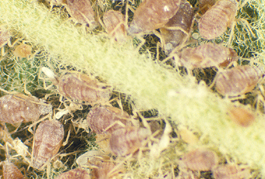
Rosy apple aphid, introduced into the United States about 1870, is usually well controlled under conventional management programs but can be severe in certain years or locations. In those years, rosy apple aphid is the most severe aphid pest, as its feeding causes small, deformed fruit and leaf curling. Curled leaves provide refuge for subsequent generations, making control difficult. Early recognition of a potential rosy apple aphid problem is necessary to obtain control. Rosy apple aphid has recently emerged as a significant pest in organic orchards, where prebloom control measures are inadequate.
Hosts
In the spring, the rosy apple aphid feeds on apple leaves and fruit. In summer, it moves to alternate herbaceous hosts, such as broadleaf and narrowleaf plantain. Rosy apple aphid will attack all apple varieties, but Golden Delicious and Rome Beauty are among the more susceptible to fruit deformation. Although it prefers apple, it also feeds on pear.
Life stages
Egg
The oval egg is pale green when first laid and turns shiny black. It is difficult to distinguish from the eggs of the apple grain aphid and apple aphid.
Nymph
The young rosy apple aphid passes through five nymphal instars. The nymph is rosy brown or purple with a powdery white covering. Its color and long cornicles, or protuberances, distinguish it from the apple aphid, which has short cornicles.
The forms on plantain have a distinctly different appearance than those on apple. The nymphs and wingless adults are lemon yellow, and lack the whitish floury appearance that characterizes the forms on apple. This discrepancy in appearance makes it easy to mis-identify this species on plantain.
Adult
Adult rosy apple aphids on apple (wingless) are the same rosy-purple with a white bloom as the nymphs. These are the forms that reproduce multiple generations on apple parthenogenetically. The winged adult, which migrates from apple to plantain, is brownish green to black, and about 1/12 to 1/8 inch (2 to 3 mm) long.
Life history
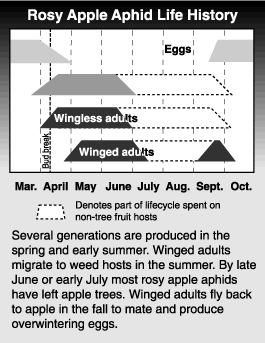 Rosy apple aphid overwinters as eggs on the bark of twigs and branches of apple trees. Eggs hatch in early spring as buds open. The eggs produce only female aphids. Nymphs feed on expanding buds, then move to the leaves of developing fruit clusters and become reproductive adults known as “stem mothers” (fundatrix) during bloom. As soon as the blossom cluster begins to separate, the aphids work their way down among the clusters and are hard to see until petal fall. Young leaves are colonized as they unfold. Mature stem mothers give birth to live nymphs without mating (parthenogenesis). Second generation adults appear 2 to 3 weeks after petal fall. A few of these have wings. Several generations are produced on apple in the spring and early summer. Each succeeding generation has a higher percentage of winged forms.
Rosy apple aphid overwinters as eggs on the bark of twigs and branches of apple trees. Eggs hatch in early spring as buds open. The eggs produce only female aphids. Nymphs feed on expanding buds, then move to the leaves of developing fruit clusters and become reproductive adults known as “stem mothers” (fundatrix) during bloom. As soon as the blossom cluster begins to separate, the aphids work their way down among the clusters and are hard to see until petal fall. Young leaves are colonized as they unfold. Mature stem mothers give birth to live nymphs without mating (parthenogenesis). Second generation adults appear 2 to 3 weeks after petal fall. A few of these have wings. Several generations are produced on apple in the spring and early summer. Each succeeding generation has a higher percentage of winged forms.
Winged adults migrate to the summer hosts, broadleaf and narrowleaf plantain. By late June or early July most rosy apple aphids have left apple trees. Winged adults produce wingless asexual forms on plantain until early fall when winged adults are produced. These fly back to apple and give birth to egg-laying females. Males, which develop a little later, return to apple and mate with the females which lay overwintering eggs.
Damage
Feeding by rosy apple aphid causes leaves to curl and deforms shoots. Toxic saliva injected into the tree as the aphid feeds on the leaves of fruit clusters stunts and distorts fruit growth resulting in small, misshapen apples.Root growth and photosynthesis are also reduced. Damage can be most severe on young trees where shoots can be distorted so badly that tree shape is permanently altered. Feeding aphids produce honeydew which drips onto the foliage or fruit. A sooty mold, Fumago vagaus Fries, can grow in the honeydew.
Monitoring
Monitoring for rosy apple aphid is impossible until after egg hatch begins, since the eggs of apple grain aphid and apple aphid are identical to rosy apple aphid eggs. Following a standard delayed-dormant oil/organophosphate application, the Pennsylvania State University recommends monitoring at the early pink stage by examining 10 to 20 trees per block. It is essential to examine leaves and clusters carefully at this time, as it is difficult to detect the few aphids present. If an average of 1 to 2 infested clusters per tree is found, then a systemic insecticide effective against aphids should be applied at the pink stage of bud development. Samples should be taken from the upper parts of the canopy on the inside of the tree where rosy apple aphid colonies are most common.
Biological control
A large number of generalist predators and parasites help control rosy apple aphid, but in many orchards substantial damage occurs before natural enemies become numerous enough to suppress aphid populations.
Management
Because rosy apple aphid is a sporadic pest in the Pacific Northwest and because of the difficulty of distinguishing its eggs from those of other species, it has been a challenge to study early season populations. According to research in Pennsylvania, egg hatch began when the first green bud tips appeared on Golden Delicious and was virtually complete by the half-inch green stage. Delayed-dormant sprays (half-inch green tip) may coincide with the end of rosy apple aphid egg hatch. It is not known if this pattern holds true in the Pacific Northwest, but every effort should be made to avoid treating too early.
Follow-up control treatments should be made from pre-pink to pink if sampling indicates a need. Use an average of 1 to 2 infested clusters per tree sampling 10 to 20 trees per block as a guide in determining the need for a follow-up treatment. As the season advances and the leaves become tightly curled, it becomes progressively more difficult to control this pest.
